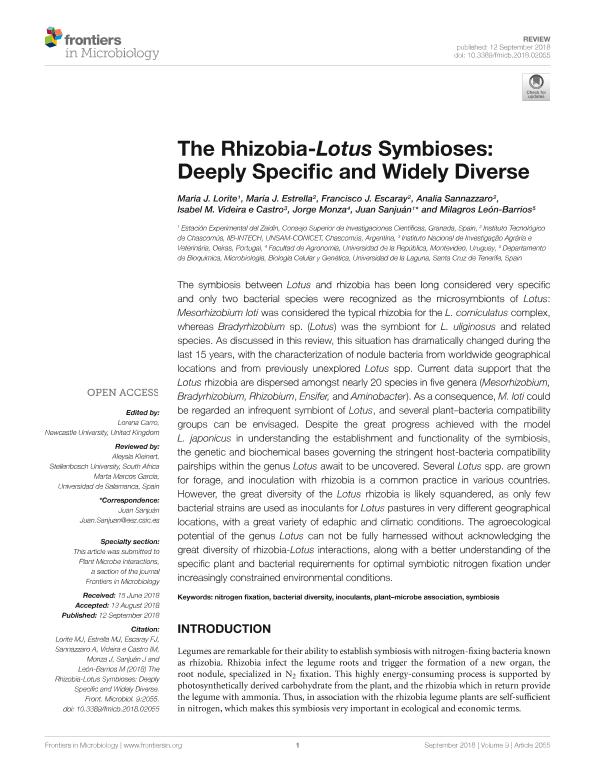Artículo
The Rhizobia-Lotus symbioses: Deeply specific and widely diverse
Lorite, María J.; Estrella, María J.; Escaray, Francisco José ; Sannazzaro, Analía Inés
; Sannazzaro, Analía Inés ; Videira e Castro, Isabel M.; Monza, Jorge; Sanjuán, Juan; León Barrios, Milagros
; Videira e Castro, Isabel M.; Monza, Jorge; Sanjuán, Juan; León Barrios, Milagros
 ; Sannazzaro, Analía Inés
; Sannazzaro, Analía Inés ; Videira e Castro, Isabel M.; Monza, Jorge; Sanjuán, Juan; León Barrios, Milagros
; Videira e Castro, Isabel M.; Monza, Jorge; Sanjuán, Juan; León Barrios, Milagros
Fecha de publicación:
09/2018
Editorial:
Frontiers Media S.A.
Revista:
Frontiers in Microbiology
ISSN:
1664-302X
Idioma:
Inglés
Tipo de recurso:
Artículo publicado
Clasificación temática:
Resumen
The symbiosis between Lotus and rhizobia has been long considered very specific and only two bacterial species were recognized as the microsymbionts of Lotus: Mesorhizobium loti was considered the typical rhizobia for the L. Corniculatus complex, whereas Bradyrhizobium sp. (Lotus) was the symbiont for L. Uliginosus and related species. As discussed in this review, this situation has dramatically changed during the last 15 years, with the characterization of nodule bacteria from worldwide geographical locations and from previously unexplored Lotus spp. Current data support that the Lotus rhizobia are dispersed amongst nearly 20 species in five genera (Mesorhizobium, Bradyrhizobium, Rhizobium, Ensifer, and Aminobacter). As a consequence, M. Loti could be regarded an infrequent symbiont of Lotus, and several plant-bacteria compatibility groups can be envisaged. Despite the great progress achieved with the model L. Japonicus in understanding the establishment and functionality of the symbiosis, the genetic and biochemical bases governing the stringent host-bacteria compatibility pairships within the genus Lotus await to be uncovered. Several Lotus spp. Are grown for forage, and inoculation with rhizobia is a common practice in various countries. However, the great diversity of the Lotus rhizobia is likely squandered, as only few bacterial strains are used as inoculants for Lotus pastures in very different geographical locations, with a great variety of edaphic and climatic conditions. The agroecological potential of the genus Lotus can not be fully harnessed without acknowledging the great diversity of rhizobia-Lotus interactions, along with a better understanding of the specific plant and bacterial requirements for optimal symbiotic nitrogen fixation under increasingly constrained environmental conditions.
Archivos asociados
Licencia
Identificadores
Colecciones
Articulos(CCT - LA PLATA)
Articulos de CTRO.CIENTIFICO TECNOL.CONICET - LA PLATA
Articulos de CTRO.CIENTIFICO TECNOL.CONICET - LA PLATA
Articulos(IIB-INTECH)
Articulos de INST.DE INVEST.BIOTECNOLOGICAS - INSTITUTO TECNOLOGICO CHASCOMUS
Articulos de INST.DE INVEST.BIOTECNOLOGICAS - INSTITUTO TECNOLOGICO CHASCOMUS
Citación
Lorite, María J.; Estrella, María J.; Escaray, Francisco José; Sannazzaro, Analía Inés; Videira e Castro, Isabel M.; et al.; The Rhizobia-Lotus symbioses: Deeply specific and widely diverse; Frontiers Media S.A.; Frontiers in Microbiology; 9; SEP; 9-2018; 1-17
Compartir
Altmétricas



